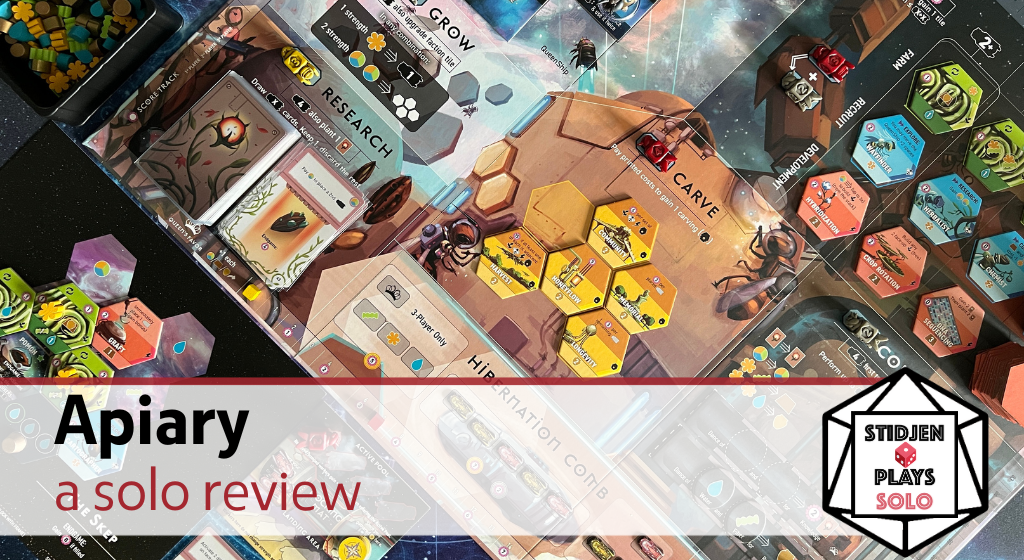
Bees are busy beings, buzzing about in the great beyond. They conceal the details of humanity’s demise, or do they just forget to mention it? They are now the winged overlords flying to infinity and beyond, but instead of being motivated by greed and expansion, they have set out to make their immediate surroundings (grown as they have, the result of being capable of space travel) a better place. Because that’s what being a bee is all about!
Name: Apiary (2023)
Designer: Connie Vogelmann
Publisher: Stonemaier Games
Play type: worker placement, variable player powers, tile placement, multi-use cards
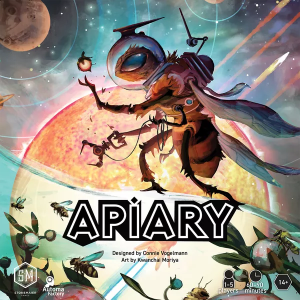
What the game is about
Can you pilot your race of hyper-sentient space bees across the universe to build the best colony? In Apiary, you control several worker bees which you’ll deploy to build up your spaceship, gather resources, and gain points.
How the game works
Please note that Apiary is not a board game dedicated to Beyoncé – she’s another kind of Queen Bee.
Apiary is a worker placement game where your workers have different strengths (that can increase over time) and whose numbers might change as well. You start the game with a unique faction tile atop a unique hive mat, which dictates starting resources and starting workers, including their strengths.
Unlike other worker placement games, a spot being occupied doesn’t mean you can’t go there. Workers go from 1 to 4; every time they get bumped from the board, you increase their value by 1 as you return the bumped worker to your mat. Once a worker of level 4 gets bumped, instead of returning to your mat, it enters hibernation. Return the worker to the supply and place a hibernation pod in a free space to gain the bonus. Once all pods are filled, or someone has placed all of their pods, the game end is triggered.
On your turn, you pick one of the following actions to take. The higher the total sum of workers present, the better the action is. Carve can only be done by a level 4 worker, while all other actions give a bonus to a level 4 worker being placed there.
- Explore to discover new planets with the QueenShip spaceship and gather resources.
- Advance your civilization by buying tiles to place on your hive mat, either increasing your resource storage, gaining one-time bonuses, or ongoing benefits for certain actions.
- Grow your colony by gaining an additional worker (if available) and/or a frame to add to your hive mat.
- Convert resources and/or Teach a dance to create your own resource conversion formula.
- Carve a special tile to gain an end-game bonus.
- Take a Retrieve turn, returning all your workers and triggering the income bonus of as many farm tiles.
The tiles you gain through either Advance or Carve are added to your hive mat, provided you have the space – that’s where the extra frames from the Grow action come in. You can build the following tiles:
- Farms provide more resource storage and bonuses for Retrieve turns.
- Recruits give you an additional benefit when you take certain actions.
- Developments provide an instant benefit that can do all sorts of things.
- Carvings are there for end-game scoring.
When you collect resources, you add them to your hive mat. If there’s no space, all the surplus is converted to progress on the Queen’s favour track, which gives an end-game bonus.
In the solo mode, you’re going up against an Automa that uses two worker colours to block various spots around the board. You flip over a card and resolve the action, using the back of the next card as a tiebreaker (like where to explore, or which tile to take). The Automa doesn’t collect or spend resources; it uses simplified actions to score points, minimizing upkeep. While they use two colours, their final score is still just one. You choose one of six difficulty levels for the Automa.
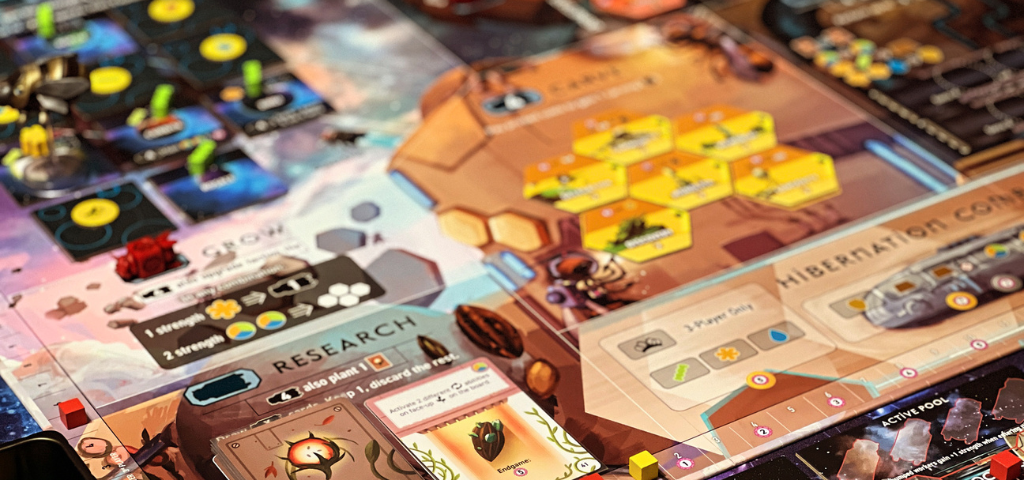
Theme, setting & narrative
Apiary can be as thematic as you want it to be. While that is pretty much true for every game ever, let me explain what I mean. On the one hand, hyper-sentient bees exploring space is clearly very much out there (right?). On the other hand, a lot, if not all, of the actions you can do bear a thematic resemblance to the inner workings of a bee swarm. Things like bees improving the habitat they’re in, hibernating, or how they communicate through dances; it’s all there. Then again, when I played it with friends, they couldn’t see past ‘but it’s bees in space’ – I could, and can, and I see a game that is surprisingly thematic. Again, if you want it to be.
How does it play?
Stonemaier Games have been on a roll for me lately; after Expeditions, Apiary came and blew me away. Yes, that is a spoiler for the rest of the review, but let me try to explain which elements speak to me, and how it all clicks.
For one, the Automa is easy to operate. I love systems that have an action card and use another card for priorities, as in Gaia Project (another Automa Factory product). There is little to no time spent on using their workers to perform an action before the turn goes back to you. Once you figure out the symbolic language of the Automa deck, your entire brain capacity can be funneled into your own strategy. I think elaborate solo modes often require thinking on your part – not necessarily about decisions, because they usually have tiebreakers for those, but more on small rules and exceptions that apply. Apiary has none of that, giving you a clear game experience, unclouded by upkeep of an opponent except for the ways they block you.
Speaking of blocking, technically there is none of that: you can place a worker wherever, bumping the worker in that slot should there be one. The only restriction is that the Carve spot can only be visited by a 4-strength worker, but even then, you can’t be blocked out of it. In fact, I often found the opposite true – because you can bump and be bumped, I was hoping for the latter if only to delay a neigh-inevitable retrieve turn for a while. It’s interesting how Apiary not only creates a refreshing take on worker placement, but also how it can flip your expectations; instead of hurrying to do something, you want to anticipate the opponent just so they bump you!
The flow of the game actually reminds me of multiplayer-game Manhattan Project, which has a similar flow of placing workers, but instead of bumping, it relies on retrieval turns to keep the board accessible. Apiary doesn’t have a similar tension, but as a result, it has a much more natural flow, and less danger of missing a beat and falling behind. Apiary also has fewer retrieval turns in general, plus, you get some goodies from doing it too! It doesn’t even feel like a lost turn like it can in Manhattan Project.
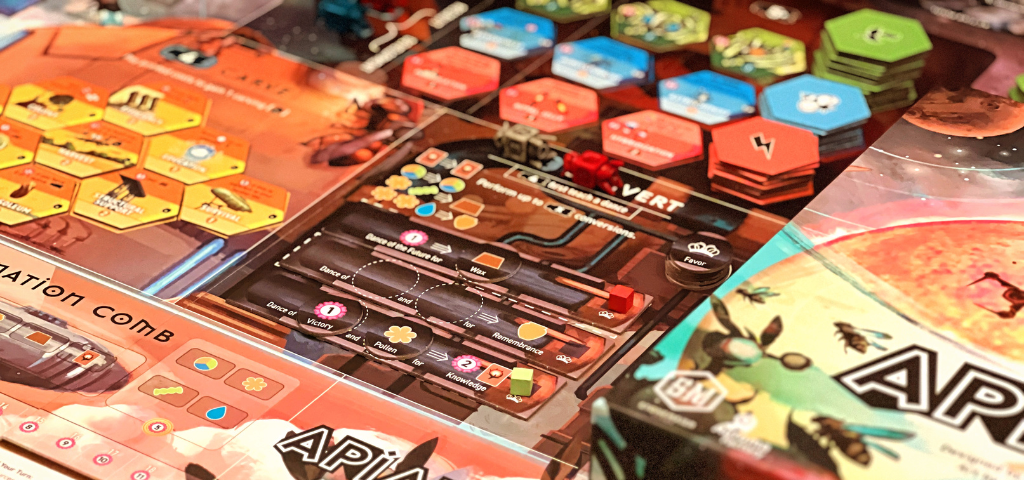
The actions you can take all feel very interesting and useful, with one notable exception – more on that later. I like how the Explore action makes a location better, which fits with how bees operate in the real world. Like I said before, if you’re willing to look past the whole ‘bees in space’ thing, Apiary is actually very thematic – how you can appease the Queen by over-producing, or how you can communicate with other bees through a Dance. Speaking of which, I find that particular action to be the weakest of all, and my multiplayer plays support this theory. I found that there is little or no reason to teach a Dance, because others will go for the basic conversions most of the time anyway. In solo play, the Dance is something the Automa altogether avoids, which exacerbates the problem.
Where the Dance action might be the weakest thing you can do, Seed cards have the potential to be overpowered, allowing you to do all kinds of things, from gaining a free Bee placement to placing a Bee as if it’s at 4 strength, and without having to hibernate afterward. Jamey Stegmaier seems to acknowledges this, providing an optional erratum on the website where you can limit Seed card plays to two per turn. Besides that, Seed cards are tremendously powerful multi-use cards, offering two other options besides playing the card. You can also tuck the card under your player board as an end-game scoring card, and you can also discard a Seed card for any of the three basic resources – but since they are so powerful, doing that should only be done as a last resort.
On the strategy front, Apiary shares some similarities with Wingspan in that your opening setup gives you some incentive to go down a certain path, but you need to keep an eye out for other opportunities. Luckily, Apiary provides the tools for you to remain flexible – the tricky part is knowing when to go all-in, or when to abandon (space)ship. And there are quite a few different starting setups, with 5 different hive mats and a whopping 20 Faction tiles. The only aspect I found a bit harder to go for (as in, it really demanded an above-average focus to make it work) was going all-in on the Queen’s favor-track. I still don’t know if it would be worthwhile points-wise to devote all your attention there; if the effort is worth the result.
Besides the careful cadence of strategy and tactics, timing is an issue as well; or rather, I should say ‘challenge’. If you don’t want to take a Retrieve turn, you need to carefully manage your workforce and are sometimes dependent on whether or not the Automa will bump a key worker or not. You are constantly on the lookout of how your workforce will look a few turns from now, and if you need to do something else in order to change that. More often than not, the end of the game comes rushing out of nowhere, and your carefully laid plans might vanish all of a sudden. There is a lot to discover here, and if you think you have the game figured out, try it again at a higher difficulty level and see how you like them apples.
What you might like
- The Automa is easy to operate while getting in your way and adjustable in difficulty – in short, one of the best ones out there (at least for me)
- The game has a natural flow to it; there is no worker blockage, and you
- Your workers grow stronger and eventually hibernate, creating a flow and cycle within each game
- Seed cards are multi-use and very powerful – potentially too much so, given they’ve gotten an erratum optional rule to limit their plays to 2 a turn
- Apiary’s variable setup (5 hive mats times 20 faction tiles equals 100 unique setups) offers you a certain strategic path you could go down, but you don’t have to – and there are plenty of other tactical opportunities to profit from if you know how to leverage them
What you might not like
- I wish the Dance mechanism would have some way to make it work in solo play – but from my multiplayer plays, I found Dance, in general, to be sub-par when compared to other actions (so maybe the action as a whole is where the problem lies)
- The game might end all of a sudden if you don’t know where to look, when the number of Hibernations rapidly increases (but to be fair, this isn’t necessarily a bad thing)
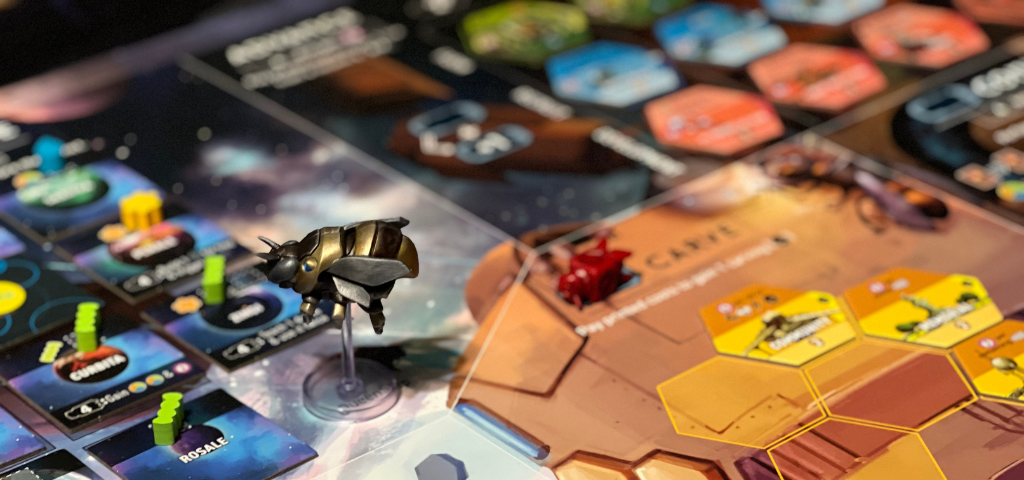
Conclusion
Even though they have quite the track record of amazing games, Apiary is my favourite game by Stonemaier Games as of this writing. The way it opens up worker placement without losing tension is a tremendous feat and one that keeps me coming back just because it plays so quickly. When I got this for Christmas, I just couldn’t stop playing it. I’ve played a fair bit already, but I know there is so much more for me still to discover. When a game keeps occupying your mind after the fact, thinking about things you could’ve done differently, you know you have a winner on your hands.
Rating: ★★★★★
Thank you for reading! If you like my content, please consider buying me a coffee or supporting me on Patreon. If this review was helpful to you, tell the publisher!
